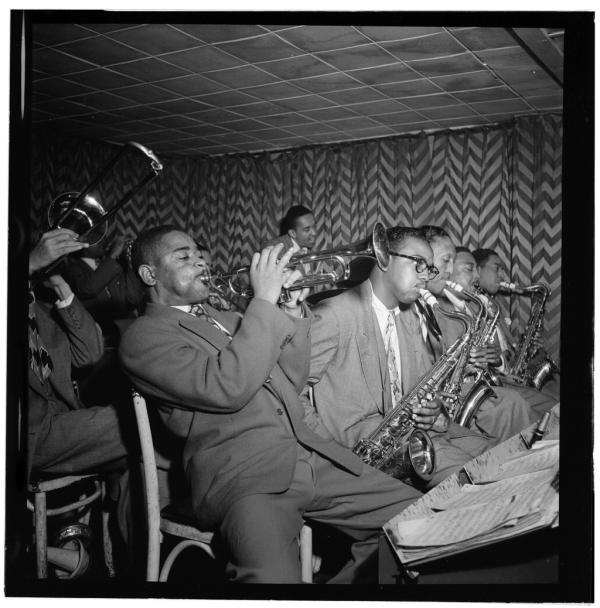Virtual Bookshelf: Jazz Appreciation Month

Portrait of Dizzy Gillespie, James Moody, and Howard Johnson, Downbeat, New York, N.Y., ca. Aug. 1947, by photographer William Gottlieb
Library of Congress, William P. Gottlieb Collection

Portrait of Dizzy Gillespie, James Moody, and Howard Johnson, Downbeat, New York, N.Y., ca. Aug. 1947, by photographer William Gottlieb
Library of Congress, William P. Gottlieb Collection
Celebrate Jazz Appreciation Month this April with these NEH-supported resources:
The Jazz Ambassadors
During the Cold War, the U.S. Department of State sent the country’s best jazz musicians abroad, promoting tolerance at the height of the civil rights movement. In this NEH-funded documentary, archival footage brings to light the pivotal questions the program raised about the role of diplomacy, race, and music in bringing communities together.
The Jazz Loft According to W. Eugene Smith
This WNYC film, which received $704,000 in funding from NEH, tells the story of photographer W. Eugene Smith, who from 1957 to 1965 recorded 4,000 hours of tape and took 40,000 photographs of the city’s legendary jazz musicians from his home on Sixth Avenue in New York City. Among the artists featured in Smith’s work are Bill Evans, Charles Mingus, and Thelonious Monk.
Archibald Motley: Jazz Age Modernist
Born in New Orleans and raised in Chicago, painter Archibald Motley rose to acclaim in the 1920s Harlem Renaissance. Focused on urban landscapes, Motley’s work has a spirited charm to it. In this NEH-funded traveling exhibition, Motley’s lively dance scenes and intimate portraits come alive alongside a catalog and related workshops and discussions.
Dig That Lick
In this joint project with the University of Illinois, Columbia University, and partner institutions in Europe, researchers are mining jazz recordings to better understand the genre’s social and cultural resonances. Using computational analysis, the interdisciplinary project allows researchers to study large collections of jazz tapes and documentation to create a fuller picture of the genre’s place in society.
Mapping the Legacy of Jazz and Hip-Hop in Queens
In a forthcoming exhibition and website, the Louis Armstrong House Museum is tracing the history of jazz in Queens. The exhibition, which received $30,000 in funding from NEH, will allow visitors to explore in person or online the neighborhoods that shaped the genre and brought it to new audiences.
New Directions in Digital Jazz Studies
With funding from NEH, the University of Illinois is using algorithms to broaden access to the U.S. Institute of Jazz Studies collection and the Scottish Jazz Archive. Awarded $149,031 the trans-Atlantic project will analyze audio and other materials to help scholars studying the history of jazz better understand the genre’s place in the broader field of musicology.
Harlem Speaks
Originally conceived as a series of public programs—Harlem Speaks, Jazz for Curious Listeners, and Jazz for Curious Readers—the National Jazz Museum in Harlem is bringing the history of this unique genre to new audiences online. Curated by senior scholar Loren Schoenberg with funding from NEH, the series is free and available on the museum’s website, featuring episodes on Benny Golson, Delilah Jackson, and Hank Jones.
Timeline of African American Music
In 2019, Carnegie Hall was awarded $100,000 to develop an interactive, digital timeline of African-American music. The mobile-first design features stories about jazz’s Caribbean and Latin influences, its mid-century transitions, and its place on a global stage. Spanning 400 years, the timeline’s breadth paints a rich picture of African-American music and its unmistakable sound in jazz.
EDSITEment
NEH’s educational website, EDSITEment, offers lessons plans, discussion questions, recommended readings, and other resources for parents, families, and K-12 educators. Students can learn about female jazz legends Nina Simone and Ella Fitzgerald using the Jazz Appreciation Month closer readings commentary. The Jazz and World War II lesson plan explores the connections between jazz musicians and the Second World War. Jazz Beyond Borders provides links and information on the global influence of jazz music, while the media resource The Jazz Ambassadors provides clips from the PBS film along with accompanying discussion prompts about cultural diplomacy. The Music of African American History encourages students to think about the ways in which music has informed and reflected African-American culture and history.
Humanities Magazine Articles:
Jazz Record
When Jazz Moved to Chicago
Wynton Marsalis
Tenor of the Times
What It Means That We Are Lindy Hopping Again
Vaudevillian Jazzman
Block Party
What Is Music?
Black Swan Rising
Studs Terkel
Quincy Jones